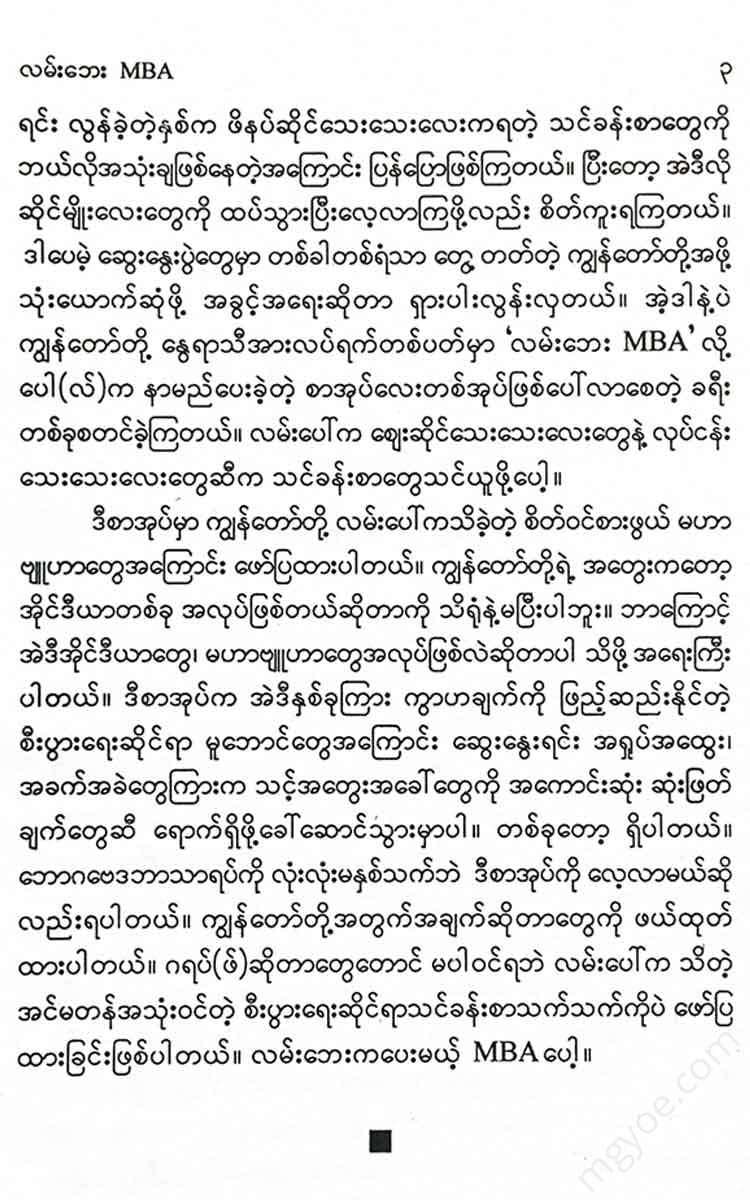စိတ်ကူးချိုချိုစာပေ
Aung Sithar - Streetside MBA
Aung Sithar - Streetside MBA
Couldn't load pickup availability
Chapter [1]
Expanding a business
We started our trip by trying to find some interesting little businesses that were hidden away. We found them on a Sunday morning. We spent our first day as tourists, taking in the scenery, enjoying the misty sunsets, and having a barbecue and a fun dinner. The next Monday morning, we woke up to a bright sun and had a quick breakfast at the Holiday Inn. Then we headed northwest. Towards the mountains that line the Mississippi River. As we continued on our way, I looked back at Mike, who suggested we stop for coffee. Scott asked if the breakfast we had just had wasn’t enough coffee. So Mike said, “What are you going to do, sitting in the car, because you have forty-five minutes to go to another meeting?”
Then we went to the nearest Starbucks. We ordered coffee at the counter and stared at the early morning Starbucks crowd as we waited for our coffee. Paul took his long cup of coffee and asked if we were going to learn about small businesses, or if we should be in another small coffee shop that was independent of this one. And so our conversation turned to how Starbucks, which was once just one store, became a global company with thousands and thousands of stores. That success is a promising example of what is always possible for small businesses that want to grow. While discussing Starbucks’ success, we were able to set a framework for which companies to visit first on our road trip. It was a thought-provoking piece about how businesses grow. Are there any factors that limit their growth when they try to expand? How can companies scale effectively and what mistakes should they avoid? We've seen companies that are trying to grow their businesses in unique and innovative ways. Some of them are even achieving acceptable success for their size, and we've learned that they're still trying to grow. One important question for small business owners when it comes to scaling their businesses is what determines successful scaling...
Jonesboro, Arkansas
BRACES BY BURRIS Dental Clinic Practice
Consolidate operations to reduce costs
After a full day of caffeine and a week in Jonesboro , we headed to Braces By Burris Dental Clinic to meet with the office manager, Norma Stans. We were a little confused when we got there. After all, we thought a dental clinic would have a reception desk. And we thought it would be a place where children who were afraid of having their teeth extracted and patients waiting to be seen. Instead, we arrived at a place surrounded by glass rooms and square work tables, and we wondered if we had gotten the wrong address.
“Welcome to our headquarters,” said Jana, tall, with thick glasses and a smart white suit. She welcomed us into her office and explained the geography of Arkansas. “And we also have a practice in West Memphis that we bought out from a retired dentist. And we have a practice in Forest City and Beverly. All of those are within sixty miles of Jonesboro.” She ran through the list of practices, which took up the first fifteen minutes of our interview. Over the past several years, Dr. Barris, the owner of the practice, has expanded his practice by opening new locations in many new areas. So, as Norna explained, we have been to eleven Barris locations in total, and now we have a headquarters and management office for all of the Barris practices. Many of the cities that Dr. Barris has expanded into are actually small towns. And the practice doesn’t have to be open every day.
“We have a rotating schedule for our clinic locations. In fact, we operate our entire clinic with two or three traveling teams of two assistants and one dentist. We are still forming some new teams to send out to other dentists and other locations. Sometimes it takes days. Many surgeries and treatments are done in the Jonesboro area. Although we have a lot of equipment in each clinic, we carry some of the most important clinical equipment in our vehicles when we travel. When we go to some of the more remote locations, sometimes we leave at 7 a.m. and don’t get back until 6:30 p.m.,” explains Shawner.
“What do they do in this office?” Mike asked. “ It’s our administrative office. We have accounting, human resources, IT, billing, collections, and the call center. We have five people answering all the calls. Most of them are local numbers. They all ring from the same phone. And we answer them all the same way,” Rona explained.
Barris Clinics grew out of a desire to serve people who didn’t want to travel to a far-flung dental clinic. Providing dental care is more than just a small office with a small reception area and a small, visible clinic. Opening a branch office in a suburban area is much cheaper than renting a space. The headquarters helps to open multiple branches and operate them smoothly with small mobile teams. By handling billing and insurance in one place, each clinic has less staff to handle the job. This practice is supported by the fact that Arkansas, where their clinics are located, is one of the few states that offers dental health insurance. Barris Dental’s centralized system fits in well with Arkansas’s regulations, which require a lot of red tape when it comes to getting dental insurance. Centralized control and management of mobile clinics has greatly improved the quality of dental clinics in the city.
There is an economic concept that reduces the cost per unit by producing more. It is called Economies of Scales. Barris Dental Clinics have grown by discovering and exploiting one of the first laws of profitable growth, Economies of Scales. Economies of Scales are, as mentioned above. As the number of products increases, the company becomes more profitable and can operate at lower costs. To understand this concept, you need to understand three definitions of cost in economics. The first is average cost. Average cost is the total cost of producing a product divided by the total number of products produced.
The second is fixed costs. Fixed costs are costs that a business incurs no matter how many units it produces. These costs include building rent, equipment, and business license fees. For Barris Clinic, all of the costs for its headquarters in Jonesboro are fixed costs that do not change with the number of patients it produces. The third is variable costs. In other words, they are non-fixed costs that change with the number of units produced. The more units produced, the higher the variable costs. In some industries, inputs are important variable costs. For example, a car manufacturer may have to buy four more tires if it sells more cars. But in other industries, variable costs are very small. For example, Microsoft has very little variable cost when it sells one more of its software CDs. That's right, because Barris's office can handle all of its administrative tasks at its headquarters, the additional variable costs it incurs for its small mobile teams are very low. Economies of Scale usually occur when fixed costs are greater than variable costs. The reason is simple. As production increases, the total fixed costs remain the same, and the fixed costs per unit decrease. And as economies of scale improve, growth leads to increased profits for two reasons. The first is that productivity increases and average costs decrease. Imagine, a situation where your business's average cost per unit decreases as your output increases, which is a great opportunity for any small business.
Barris Clinic has taken advantage of economies of scale. By centralizing the back-office operations and bringing them together in one place, they have reduced their overall costs. By storing the small plates and wires used in dental restorations in one place, they have a cost advantage. Needless to say, storing hundreds of different sizes and shapes of dental supplies in one location would be expensive. So, instead of storing them all over the place, it was the most cost-effective and efficient way to store them in one location, says Schoener. Barris Clinic has been able to expand its footprint to cover a wide range of locations without incurring additional costs. This has allowed them to serve a larger number of customers and share the fixed costs of the business, creating effective economies of scale.
Paul wanted to know how far Barriss Dentists could expand. “One of our locations is four hours away. It’s so small, we only go once a month. We just load up a plane and head down,” Shawn gave an example. Scott wasn’t sure, so he asked, “Wait a minute, did you say plane?” Yes. Dr. Barriss flies to central Arkansas once a month. That experience is great,” Shawn replied, not surprisingly.
We really didn’t expect to be talking to a small dental practice that had its own aircraft. Centralizing business operations and spreading fixed costs across as many locations as possible is important for the Barris dental practice. By using mobile clinics, the Barris team can effectively travel to many locations, which is an advantage over some stationary dentists. The more locations they can serve at the same time, the more patients they can serve, and the larger the business.
Denver Steel & Rubber Products Group, North Carolina
The potential for revenue to exceed fixed costs
The three of us professors continued our journey to the Hickory region of North Carolina, where most of the furniture manufacturing industry is based. The region's dense forests and transportation facilities are a great help to the furniture industry.













